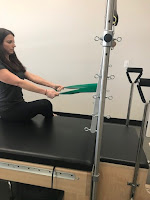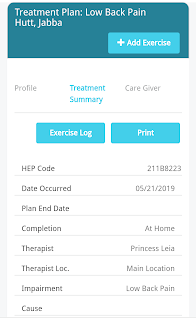by guest blogger Sigourney Cross, DPT at
Pelvic Health and Rehabilitation Center
Pelvic and low back pain during pregnancy affects up to two-thirds of women and can start anytime from the first trimester to months after giving birth.1 This is due to a couple of reasons. First, there is a change in your hormone levels. Increased levels of the hormones relaxin, estrogen and progesterone begin to loosen the ligaments that hold your pelvis together in order to prepare you for childbirth. When these ligaments get stretched too far, it can cause pain. Another cause for pain is your rapid weight gain. As your belly grows during pregnancy your center of gravity is shifted forward. This causes an increased lordosis or pronounced curvature of your low back. This places excessive strain on your lumbar spine as well as the muscles and ligaments around the pelvis. When pregnant you may also spend more time resting and sitting which can lead to muscular imbalances, weakness and trigger points.
The pain location and type women experience varies. Pain can be experienced in the lower back, top of your hip bones, back or front of your hips, groin, over your buttocks, down the back of the legs, over the pubic bone and into the vulva. The nature of the pain can be anywhere from a mild to severe achiness, stinging or burning sensation, or sharp and stabbing sensation. Thankfully, there are multiple measures women can take to alleviate their pain including pregnancy support garments such as leggings, belts, bands or girdles, sleep pillows for optimal posture and alignment, acupuncture, pregnancy approved pain relievers, prenatal massage, prenatal pelvic floor physical therapy, and of course exercise! Women with uncomplicated pregnancies are encouraged to engage in aerobic, stretching and strengthening exercises with the necessary modifications to ensure safety for both mom and baby. According to The American College of Obstetricians and Gynecologist an exercise program during pregnancy should include moderate intensity exercise for at least 20-30 minutes per day on most days of the week.
The following exercises can ease the aches and pains of pregnancy and prepare your body for the rigors of labor.
1.
Cat-Cow (Mad Cat/Saggy Nag): Being on all fours, keeping the top of your feet flat on the ground. Your hips should be aligned directly over your knees and your shoulders over your wrists. To get into the cow inhale while letting your back arch and belly drop. Keep shoulders rolled back while looking slightly up. As you exhale, round your upper back and shoulders while looking down at your belly. This is cat. Continue moving into your cow on your inhales and cat on your exhales. This exercise helps increase spine mobility and circulation and gently strengthens your low back helping ease hip, pelvic, low back and round ligament pain.
2.
Bridges: Begin by lying on your back with your arms at your sides. Bend your knees so that your heels are close to your butt. Next, press your heels into the floor and lift your hips up until you form a bridge with your body. As you are lifting your hips, remember to squeeze your butt muscles, hold this pose for a second at the top before slowly lowering your body back down. This exercise can help ease back pain by strengthening your glutes (butt muscles), low back and abdominals as well as providing a gentle stretch to your hip flexors.
3.
Child’s Pose: Start out on all fours with your ankles together and knees wide apart. Next, slowly sit back bringing your butt down to your ankles as low as you can go. Then stretch your arms out in front of you on the floor. Allow your weight to sink down and back to slightly round. Hold this position for a few minutes, while breathing deeply. This is a great stretch for low back and hip pain. It helps elongate your spine and take away tension from the added weight you are now carrying, by relieving pressure on the surrounding nerves. This is also a great exercise to relax your pelvic floor muscles!
4.
Seated Piriformis Stretch: Sit on a chair with your feet flat on the ground. Cross one foot over the other knee making the number 4. Lean forward keeping your back flat until you feel a stretch in your low back and buttocks of your top leg. Hold this position for 30-90 seconds and repeat on the other side. The piriformis muscle is a small muscle deep in the glutes that can spasm during pregnancy. This can often cause back and leg pain because it extends across the sciatic nerve. Gentle stretching of this muscle can help decrease tightness and pain.
5.
Seated Row: You can use either free weights or resistance bands. Begin in a seated position with your back upright. Tighten your abdominal muscles and have your arms extended forward in front of you. Slowly pull the weights or resistance band all the way towards your stomach, keeping your elbows down at your sides while pulling your shoulder blades together. Hold this position for one second before slowly returning to your starting position. Repeat. Remember to keep your shoulders down and back during this exercise. This is a great exercise to help improve your posture, relieve back pain and strengthen your back muscles and as they become weaker with your growing belly.


Other exercises that have been proven to be beneficial in preventing and/or reducing pelvic pain include walking, swimming and prenatal yoga. Walking is the number one option for many women as its low-impact, a great way to maintain and improve your cardiovascular fitness, easy to make a part of your daily routine and free! Swimming is another great way to get exercise, especially later in your pregnancy as the buoyancy of the water takes the strain off your joints and ligaments. Finally prenatal yoga is a great way to keep your core strength, flexibility and balance in check. It’s important to remember to maintain a mild to moderate intensity while exercising, to take frequent breaks, practice good form and posture, and avoid positions or movements that increase pain or discomfort. Whether you’re a seasoned athlete or a beginner, be sure to get clearance from your doctor before starting an exercise program while pregnant. Women with higher risk pregnancies may have more restrictions.
If these exercises don’t do the trick I recommend getting a physical therapy evaluation for a more focused program that fits your needs.
References:
- Physical activity and exercise during pregnancy and the postpartum period. Committee Opinion No. 650. American College of Obstetricians and Gynecologists. Obstet Gynecol 2015;126:e135–42.
- Prendergast, SA. Pelvic floor physical therapy for vulvodynia: a clinician’s guide. (2017). Obstetrics and Gynecology Clinics of North America, 44(3), 509-522.
- Babycenter.com
About Sigourney Cross, DPT

Sigourney grew up just outside Minneapolis, MN. She graduated from the University of Minnesota with a Bachelor’s degree in Journalism followed by her Doctor of Physical Therapy degree from Hampton University. Having worked across the country and being licensed in six states, she brings a wealth of experience and knowledge to
Pelvic Health and Rehabilitation Center (PHRC). Sigourney looks forward to sharing her expertise with patients to help them gain a better quality of life. When not working, she enjoys playing the piano, dancing, trying new restaurants and spending time with family and friends.





















